Taking high-angle photos with your phone can transform ordinary scenes into extraordinary compositions. You'll capture unique perspectives that reveal intriguing patterns and geometric shapes in everyday objects and environments. High angles are great for flattering portraits and selfies, minimizing double chins and making eyes appear larger. They also emphasize foreground elements, create depth, and simplify compositions by reducing background distractions. When photographing landscapes or architecture, elevated viewpoints showcase features and patterns not visible at ground level. High-angle shots are perfect for food photography and group photos too. By mastering this technique, you'll open up a whole new world of creative possibilities with your smartphone camera.
Unique Perspective on Everyday Scenes
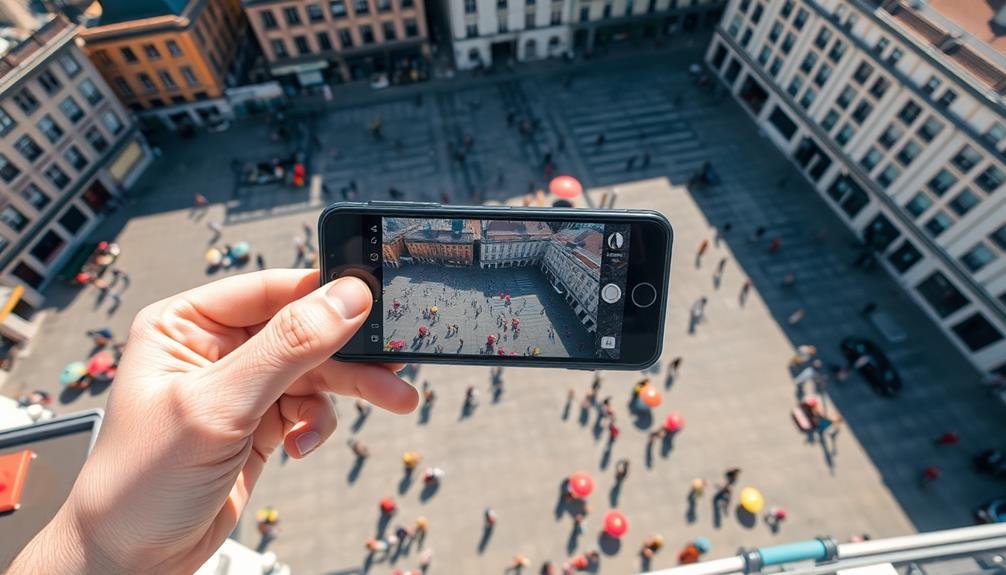
A bird's-eye view can transform the ordinary into the extraordinary. When you take high-angle photos with your phone, you're offering viewers a fresh perspective on familiar scenes. Everyday objects and locations suddenly become intriguing patterns and compositions when viewed from above.
Look around your neighborhood or city with new eyes. That bustling street corner you pass every day? From above, it becomes a fascinating network of intersecting lines and moving dots. Your local park transforms into a patchwork of green spaces and winding paths.
Even your own living room can take on a new life when photographed from a high angle, revealing unexpected symmetry or visual interest in the arrangement of furniture.
Don't limit yourself to grand vistas. Everyday items like your morning coffee setup, a workspace, or a meal preparation can become mesmerizing subjects when shot from above. You'll start to notice textures, shapes, and color combinations you've never appreciated before.
High-angle photography encourages you to see the world differently, turning mundane moments into artistic opportunities. It's a simple technique that can dramatically enhance your visual storytelling skills.
Flattering Portraits and Selfies
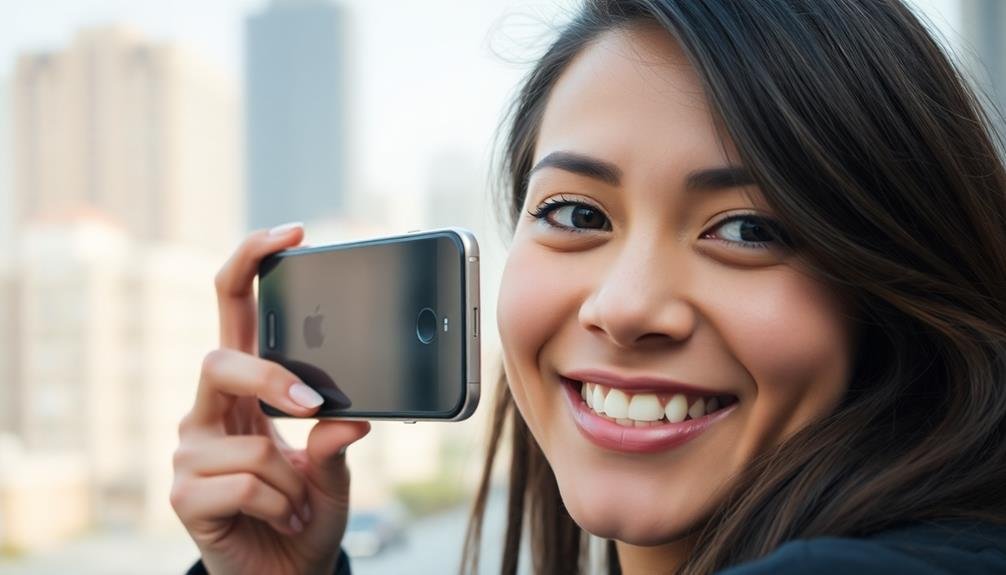
Many people struggle with capturing flattering portraits and selfies, but high-angle shots can be your secret weapon. By holding your phone slightly above eye level and angling it downward, you'll create a more slimming effect and minimize the appearance of double chins. This technique also emphasizes your eyes, making them appear larger and more enchanting.
When taking high-angle portraits of others, you'll notice how it adds an air of confidence to your subjects. It's a subtle yet effective way to make people look their best without resorting to filters or heavy editing. Here's a quick guide to high-angle portrait techniques:
| Angle | Distance | Lighting |
|---|---|---|
| 15-30° | Arm's length | Natural, diffused |
| 45° | 2-3 feet away | Side-lit |
| 60-75° | 4-5 feet away | Backlit |
Remember to experiment with different angles and distances to find what works best for each individual. You'll soon discover that high-angle shots can transform your portraits and selfies, giving them a professional and flattering look that'll make your social media posts stand out.
Emphasizing Foreground Elements
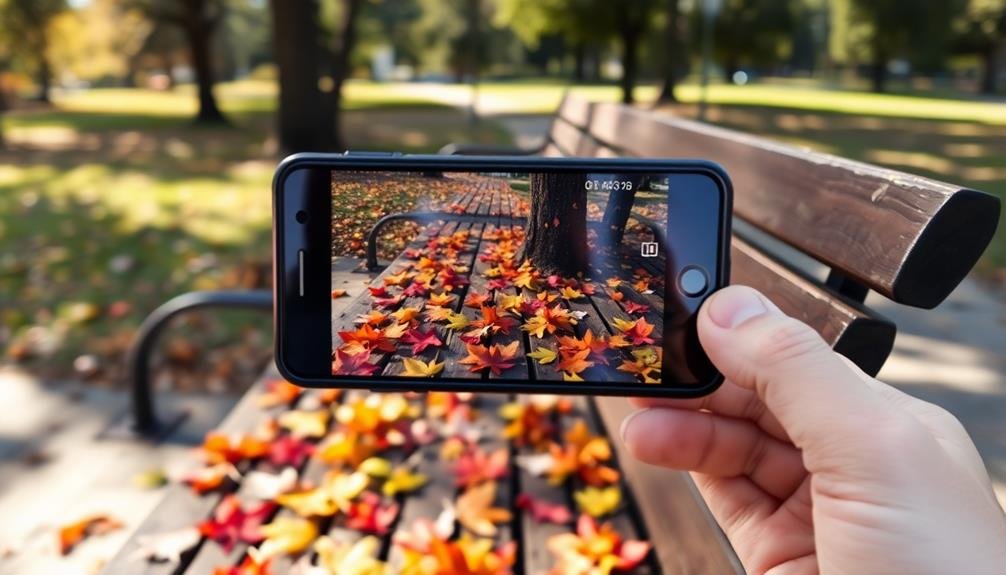
High-angle shots aren't just for portraits; they're excellent for emphasizing foreground elements in your compositions. When you shoot from above, you can create depth and interest by showcasing objects in the foreground against a broader background. This technique works particularly well for flat scenes or when you want to highlight specific items.
To emphasize foreground elements, position your phone higher and angle it downward. This perspective allows you to include more of the foreground in your frame, making objects appear larger and more prominent. It's especially effective for food photography, tabletop arrangements, or capturing details on the ground.
Try experimenting with different heights and angles to find the perfect balance between foreground and background. You can create leading lines that draw the viewer's eye through the image by positioning foreground elements strategically.
Don't forget to take into account the background, though; it should complement your foreground subject without overpowering it.
Remember to keep your phone steady when shooting from high angles. Use both hands or a selfie stick for stability. With practice, you'll master the art of high-angle photography, creating compelling images that showcase foreground elements effectively.
Creating Depth in Compositions
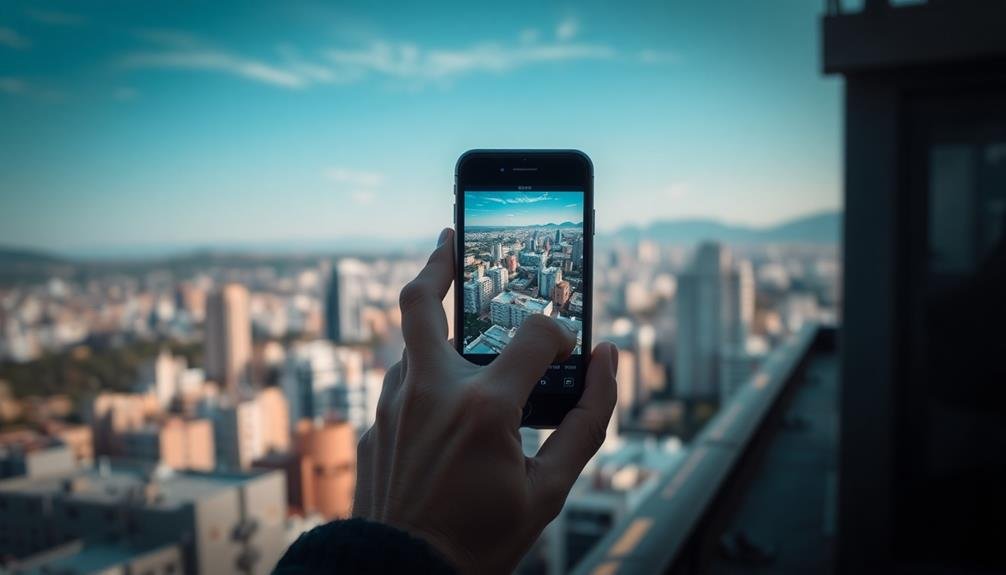
When shooting from high angles, you'll want to create a sense of depth in your compositions.
Try layering foreground and background elements to give your images more dimension and visual interest.
Layering Foreground and Background
Creating depth in your high-angle phone photos involves three key layers: foreground, middle ground, and background. Mastering this technique will elevate your images from flat snapshots to dynamic compositions that draw viewers in.
Start by identifying a strong foreground element. This could be anything from flowers or rocks to a person's hands. Position your phone to capture this element prominently in the lower part of the frame.
Next, focus on the middle ground, which might include the main subject of your photo. This layer bridges the gap between near and far elements.
Finally, incorporate an interesting background. When shooting from a high angle, you'll often capture more of the surrounding environment, so use this to your advantage. Look for contrasting colors, textures, or patterns that complement your foreground and middle ground.
As you compose your shot, pay attention to how these layers interact. Experiment with different angles and heights to create a sense of depth and dimension.
You'll find that even subtle shifts in position can dramatically alter the relationships between foreground, middle ground, and background, resulting in more compelling high-angle photos.
Emphasizing Spatial Relationships
Three key techniques can help you emphasize spatial relationships and create depth in your high-angle phone photos.
First, use leading lines to guide the viewer's eye through the image. When shooting from above, look for natural lines like roads, rivers, or architectural features that draw attention from the foreground to the background. This creates a sense of depth and directionality in your composition.
Second, incorporate foreground elements to establish a sense of scale. Include objects close to the camera to provide context and contrast with distant elements. This technique helps viewers understand the relative size and distance of objects within the frame, enhancing the perception of depth.
Lastly, leverage atmospheric perspective to your advantage. As you shoot from higher angles, you'll often capture more of the atmosphere between you and distant objects. This natural haze can create a subtle gradient effect, with objects appearing less distinct as they recede into the background.
Embrace this phenomenon to add depth and dimension to your high-angle shots. By mastering these techniques, you'll create more visually engaging and spatially dynamic photos using your phone camera.
Minimizing Distracting Backgrounds
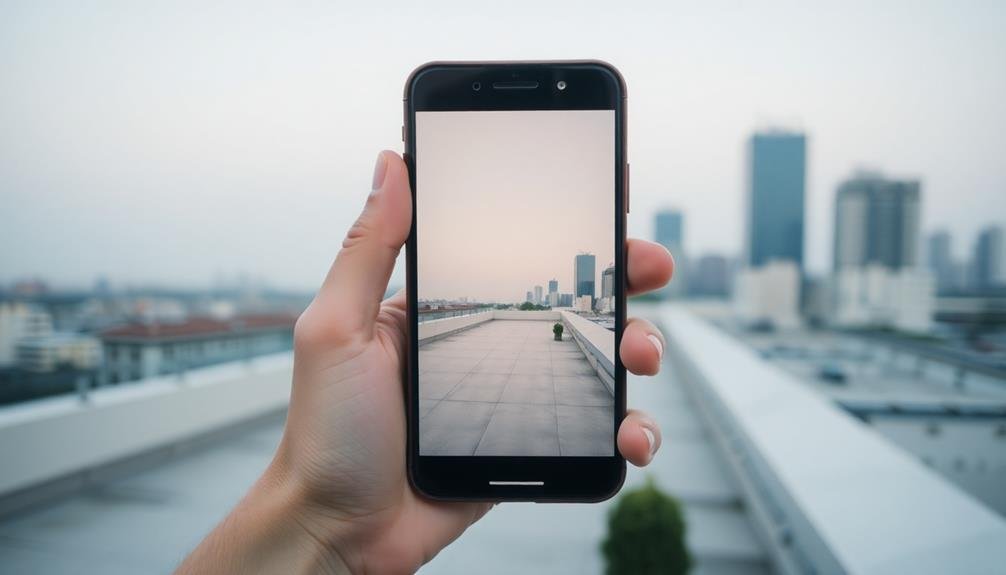
When shooting from above, you'll often encounter busy backgrounds that can detract from your subject.
To minimize distractions, focus intently on your main subject and position it to stand out against a simpler backdrop.
Focus on Subject
The focal point of your high-angle photo should be crystal clear. When shooting from above, you've got a unique opportunity to isolate your subject and make it stand out. Use your phone's tap-to-focus feature to guarantee your main subject is sharp and in focus. This is especially important when photographing small objects or intricate details that might get lost in a wider shot.
Consider using portrait mode if your phone has this feature. It'll create a shallow depth of field, blurring the background and making your subject pop. If you're photographing people, focus on their eyes to create a compelling connection with the viewer. For food photography, focus on the most interesting or appetizing part of the dish.
Remember that high-angle shots can sometimes distort proportions. To counteract this, adjust your composition to emphasize the most important elements of your subject. You might need to move closer or farther away to find the sweet spot where your subject looks its best.
Don't be afraid to experiment with different angles and distances to achieve the perfect focus and composition for your high-angle masterpiece.
Simplify Cluttered Scenes
High-angle shots offer a perfect opportunity to simplify cluttered scenes and minimize distracting backgrounds. When you're shooting from above, you can carefully control what appears in your frame, eliminating unwanted elements and focusing on your subject. This technique is especially useful in busy environments where ground-level shots might include too many distractions.
To make the most of this advantage, try these tips:
| Technique | Description | Best For |
|---|---|---|
| Isolate Subject | Frame only the main subject | Portraits, products |
| Use Negative Space | Incorporate empty areas | Minimalist compositions |
| Seek Clean Surfaces | Find uniform backgrounds | Food photography, flat lays |
Capturing Large Groups Effectively
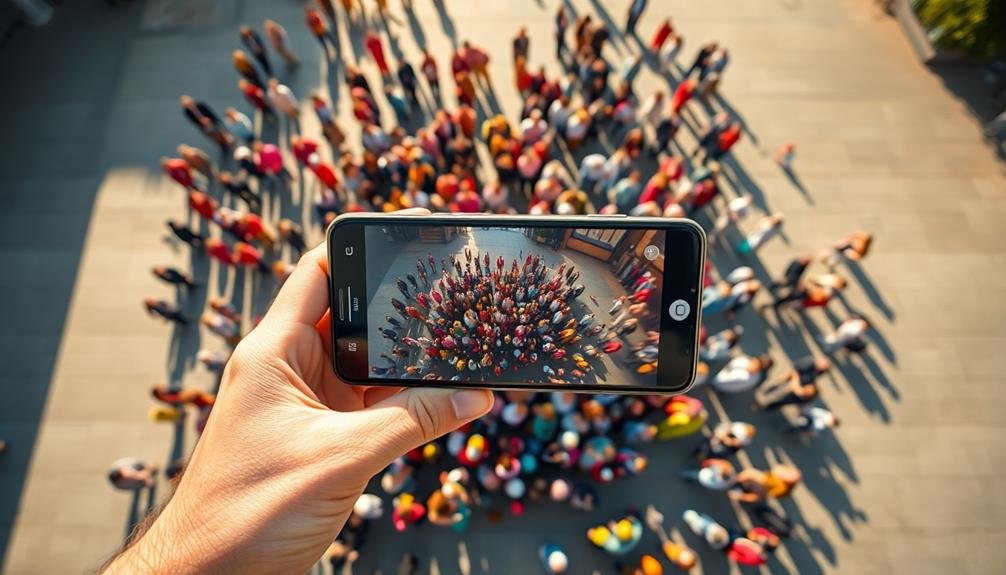
Capturing large groups from up above can transform your photos from cluttered to enchanting. When you're faced with photographing a crowd, whether it's a family reunion or a corporate event, a high angle can be your secret weapon. By elevating your phone, you'll be able to fit everyone into the frame without resorting to an overly wide shot that loses detail.
From a higher vantage point, you'll create a more organized composition. People's faces become the focus, rather than a sea of bodies. This perspective also allows you to showcase the group's formation or arrangement, which can add visual interest to your shot.
To capture large groups effectively from a high angle:
- Use a selfie stick or monopod to extend your reach
- Find elevated spots like stairs or balconies
- Ask someone tall to hold your phone up high
Remember to communicate clearly with your subjects, ensuring everyone's looking up at the camera. You'll want to take multiple shots to catch everyone with their eyes open.
Showcasing Floor Patterns and Textures
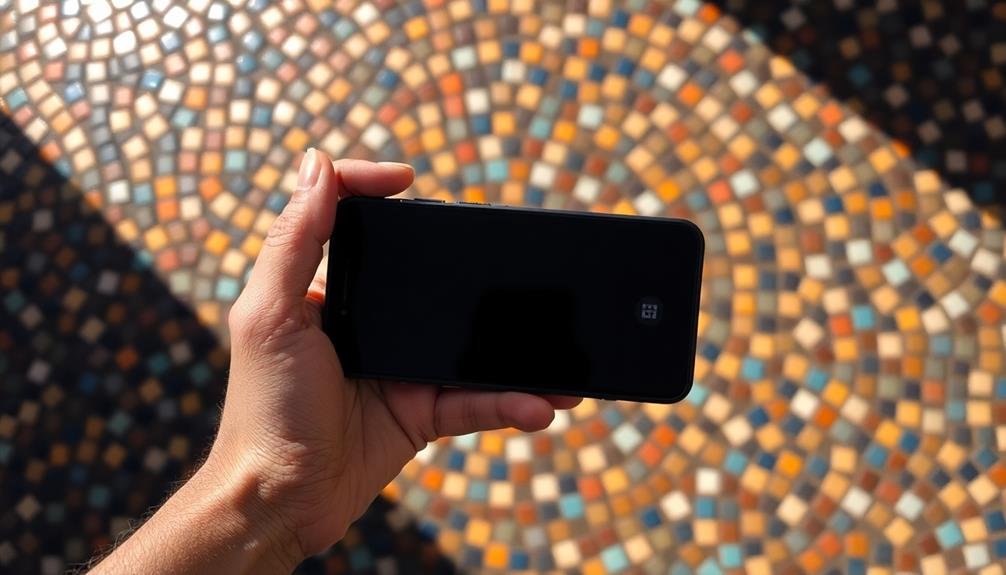
When taking high-angle photos with your phone, you can showcase striking floor patterns and textures.
Use this perspective to highlight unique floor designs that might go unnoticed at eye level. Capture intricate tile work by positioning your phone directly above the pattern, allowing the geometric shapes and colors to become the focal point of your image.
Highlight Unique Floor Designs
Floors often hide fascinating patterns and textures that go unnoticed in day-to-day life. By taking high-angle photos with your phone, you can showcase these unique floor designs and bring attention to their intricate details.
Whether you're in a historic building, a modern art gallery, or even your own home, looking down can reveal surprising visual treasures.
To capture these hidden gems, position your phone parallel to the floor and experiment with different angles. You'll want to highlight the symmetry, contrast, and repetition in the patterns.
Consider the lighting conditions and adjust your camera settings accordingly to bring out the best in the floor's texture and color.
Here are some examples of unique floor designs you might encounter:
- Intricate mosaic tiles in a centuries-old cathedral
- Geometric patterns in a sleek, contemporary office lobby
- Worn wooden planks with rich grain and patina in an old farmhouse
Capture Intricate Tile Work
Countless intricate tile works offer a stunning canvas for high-angle photography with your phone. Whether you're in a historic building, a modern hotel lobby, or a quaint café, tiled floors often feature mesmerizing patterns and textures that are best appreciated from above.
To capture these designs effectively, position yourself directly over the tiles. This angle allows you to showcase the full complexity of the pattern without distortion. You'll want to guarantee your phone is parallel to the floor for the most accurate representation. If the lighting is dim, use your phone's night mode or adjust the exposure to bring out the details.
Focus on symmetry and repetition in the tile work. You can create visually striking compositions by aligning the pattern with your frame's edges. Don't be afraid to get close; zooming in on a particularly intricate section can result in an abstract, eye-catching image.
Experiment with different heights to find the perfect balance between showcasing the overall pattern and highlighting individual tile details. Remember, the beauty of high-angle shots is that they reveal designs that might go unnoticed at eye level.
Enhancing Food Photography
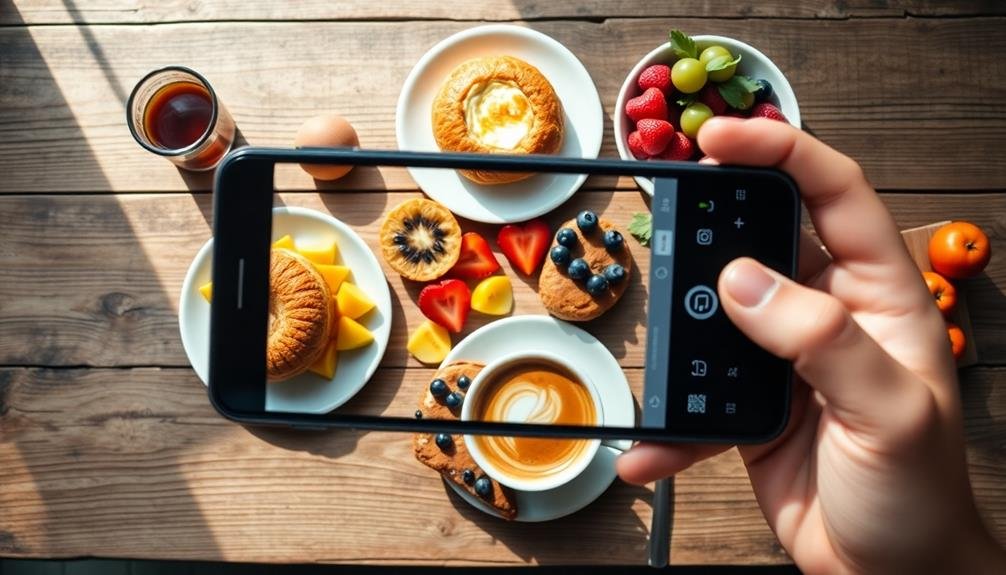
For food photography, high-angle shots can transform your images from ordinary to mouthwatering. This perspective allows you to showcase the entire dish, highlighting its composition and textures. By positioning your phone directly above the plate, you'll capture the full spread of ingredients, garnishes, and plating arrangements.
When shooting from above, you'll want to reflect on the lighting. Natural light from a nearby window works best, but avoid harsh shadows by using a diffuser if needed. Experiment with different heights to find the sweet spot that best displays your culinary creation.
Don't forget to style your shot with complementary props like utensils, napkins, or ingredients that enhance the overall aesthetic.
To create visually appealing food photos, keep these tips in mind:
- Use negative space to draw attention to the main dish
- Play with color contrast to make your food pop
- Incorporate interesting textures through tablecloths or surfaces
Highlighting Landscape Features
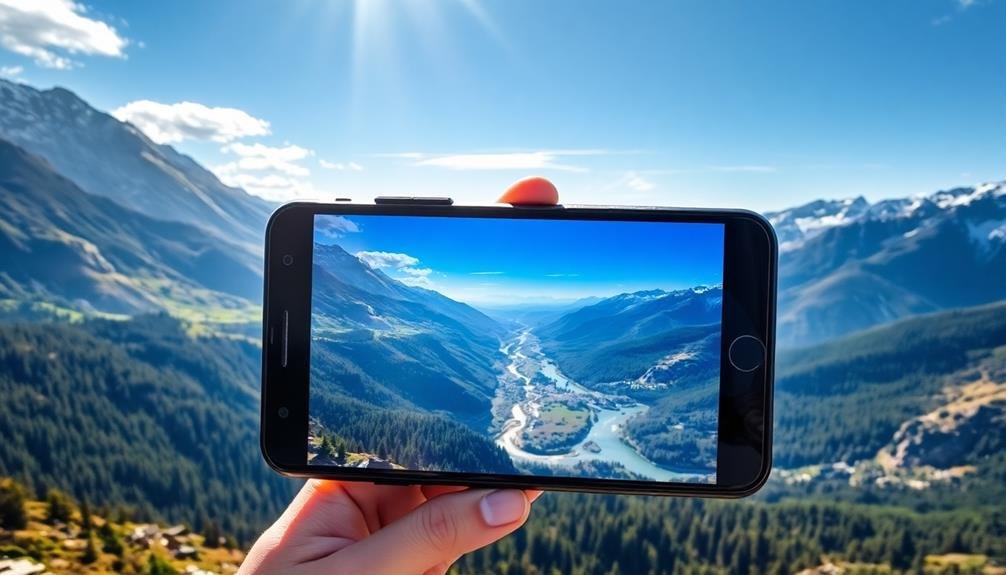
High-angle shots can dramatically enhance your landscape photography, revealing unique perspectives and hidden features. When you're capturing landscapes from an elevated position, you'll often uncover patterns, textures, and compositions that aren't visible from ground level. This technique is particularly effective for showcasing the natural flow of rivers, the intricate layout of farmlands, or the sprawling expanse of forests.
To achieve high-angle landscape shots with your phone, seek out vantage points like hilltops, observation decks, or tall buildings. You'll be surprised how even a slight elevation can transform your images. Use your phone's grid feature to align horizon lines and create balanced compositions.
Experiment with different angles to emphasize specific landscape elements, such as winding roads or geometric field patterns.
Don't forget to take into account lighting conditions. Early morning or late afternoon light can cast long shadows, adding depth and dimension to your high-angle landscapes. If you're photographing water features, try capturing reflections for added visual interest.
Accentuating Lines and Geometry
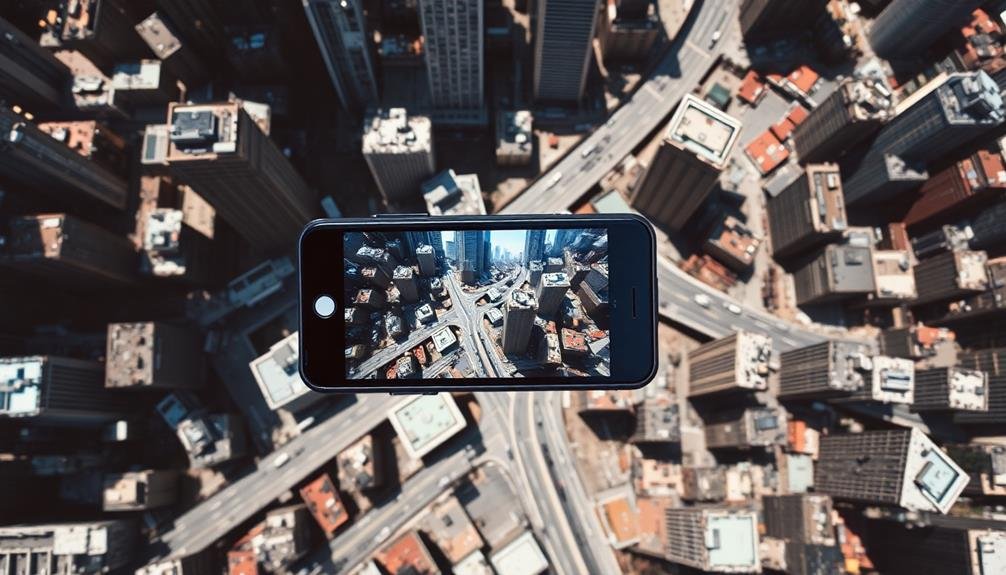
Lines and geometric shapes are powerful compositional elements in high-angle photography. When you're shooting from above with your phone, you'll often find that lines and shapes become more prominent, creating visually striking patterns and structures.
By positioning yourself at a higher vantage point, you can capture the way roads intersect, how buildings align, or how natural elements form interesting geometric patterns.
To accentuate lines and geometry in your high-angle shots:
- Look for repeating patterns in cityscapes, like rows of cars or symmetrical architecture
- Seek out contrast between curved and straight lines, such as a winding river cutting through a grid-like urban landscape
- Find intersecting lines that create dynamic compositions, like crosswalks or train tracks
As you frame your shot, pay attention to how these lines and shapes guide the viewer's eye through the image. Use them to create a sense of depth, movement, or balance in your composition.
You can also experiment with different angles to emphasize certain geometric elements or to create unique perspectives on familiar scenes.
Conveying Scale in Images

When capturing high-angle photos with your phone, conveying scale becomes a powerful tool to enhance your images. High angles offer a unique perspective that can dramatically alter how viewers perceive the size and relationships between objects in your frame.
To effectively convey scale, include familiar objects or people in your composition. This gives viewers a reference point to understand the size of other elements in the scene. For instance, capturing a person standing next to a towering skyscraper instantly communicates the building's massive size.
Experiment with different heights and distances to manipulate scale perception. Shooting from a higher vantage point can make subjects appear smaller, emphasizing their vulnerability or insignificance in a larger context. Conversely, positioning your phone closer to the ground can make foreground objects appear larger and more dominant.
Use leading lines and patterns to guide the viewer's eye through the image, highlighting the scale relationships between different elements.
Pay attention to the placement of objects within your frame, using the rule of thirds to create a balanced composition that effectively showcases scale contrasts.
Improving Architectural Photography
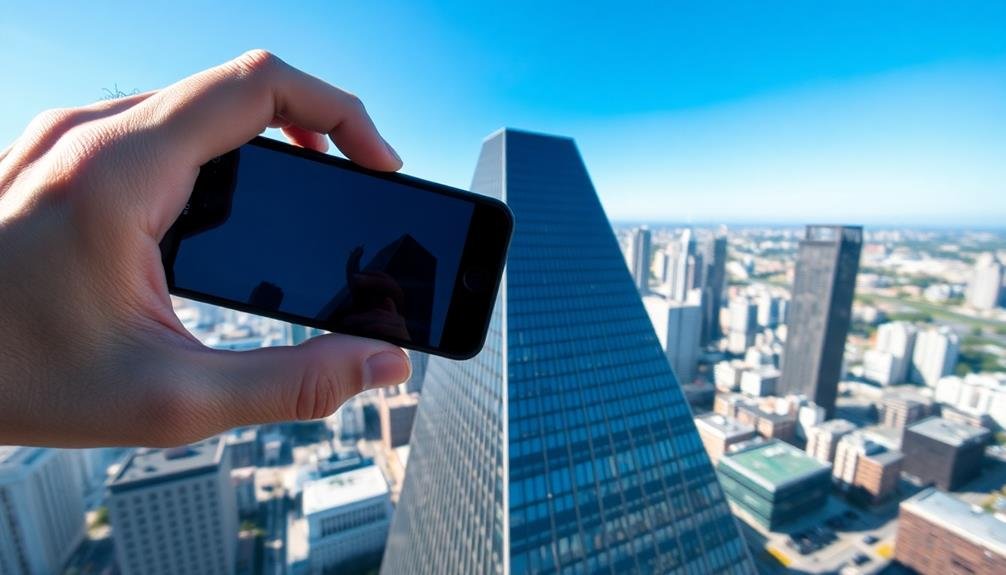
For architectural photography, high-angle shots can dramatically enhance your images. They offer a unique perspective that can't be achieved at ground level, revealing intricate details and patterns often missed by the naked eye.
When you're shooting buildings or cityscapes, elevating your phone camera allows you to capture the full scope of architectural design, from the layout of streets to the interplay of structures.
To improve your architectural photography using high angles:
- Seek out vantage points like rooftops, balconies, or nearby taller buildings
- Use leading lines to guide the viewer's eye through the composition
- Experiment with different times of day to play with shadows and light
Don't be afraid to tilt your phone to create dynamic diagonal lines in your shots. This technique can add energy and movement to otherwise static subjects.
Pay attention to symmetry and geometry in your compositions, as these elements are often more apparent from above. Remember to adjust your exposure settings to account for bright skies, and consider using HDR mode to balance the contrast between buildings and the sky.
With practice, you'll develop an eye for spotting compelling high-angle architectural shots that showcase the beauty and complexity of built environments.
Experimenting With Creative Angles
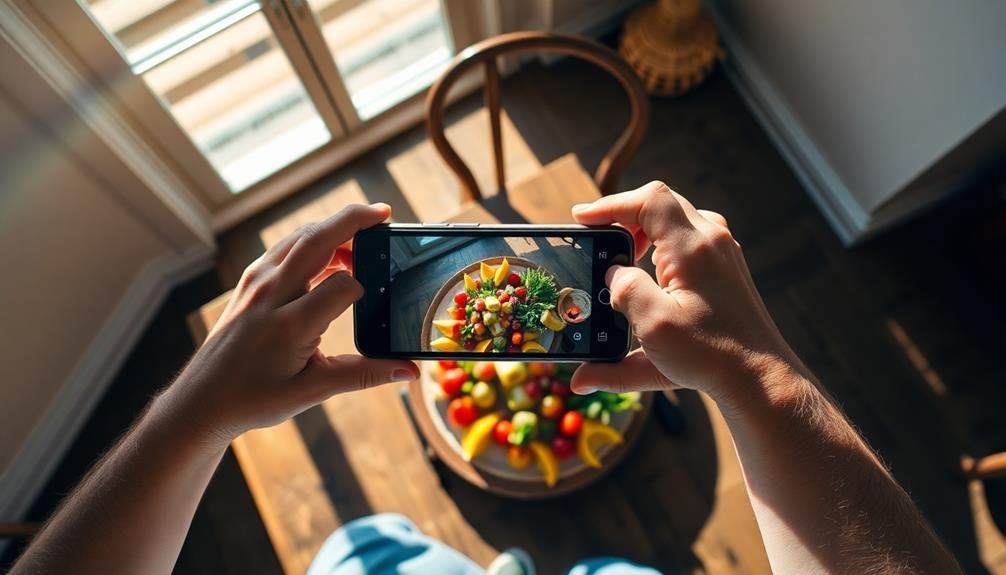
Moving beyond architectural subjects, creative angles can transform any scene into a mesmerizing image. You'll discover new perspectives that breathe life into ordinary subjects. Experiment with low angles to make objects appear larger or more imposing. Try shooting from above to create unique patterns or reveal hidden details.
Don't be afraid to tilt your phone for dynamic diagonal compositions. Use leading lines to guide the viewer's eye through the frame. Play with symmetry and reflections to add visual interest. Remember, your phone's small size allows you to position it in tight spaces or unusual vantage points.
Here's a quick guide to creative angle techniques:
| Angle | Effect | Best For |
|---|---|---|
| Low | Dramatic, imposing | Monuments, nature |
| High | Overview, patterns | Crowds, landscapes |
| Dutch | Dynamic, unsettling | Action, abstracts |
| Worm's eye | Unique perspective | Tall structures |
Frequently Asked Questions
How Do I Safely Take High-Angle Photos in Precarious Positions?
To safely take high-angle photos in precarious positions, you'll want to secure yourself first. Use a harness or stable platform, keep your phone attached to a lanyard, and don't lean too far. Always prioritize your safety over the shot.
What Equipment Can Enhance High-Angle Phone Photography Besides the Phone Itself?
You'll enhance high-angle phone photography with a selfie stick, tripod, or gimbal for stability. Wide-angle lenses expand your view, while remote shutter controls let you snap hands-free. Don't forget a phone case with lanyard for safety.
Are There Specific Camera Settings for Optimal High-Angle Shots?
For ideal high-angle shots, you'll want to use your phone's wide-angle lens if available. Enable grid lines, adjust exposure for bright skies, and use burst mode for action shots. Don't forget to lock focus on your subject.
How Do Weather Conditions Affect High-Angle Photography?
Weather greatly impacts your high-angle shots. Bright sunlight can cause harsh shadows, while overcast skies provide softer lighting. Wind may affect stability, and rain or snow can add interesting elements but require gear protection.
Can High-Angle Techniques Be Applied Effectively to Video Recording?
Yes, you can apply high-angle techniques to video recording effectively. You'll create dynamic shots, reveal more of the scene, and add visual interest. Try using a selfie stick, drone, or elevated position to capture unique perspectives in your videos.
In Summary
You've now discovered the power of high-angle phone photography. By experimenting with this technique, you'll transform ordinary scenes into enchanting images. You're not just taking photos; you're creating art. Don't be afraid to push boundaries and try new perspectives. Remember, it's all about finding your unique visual voice. So, go ahead and elevate your photography game – literally. Your followers will thank you, and you'll see the world in a whole new way.

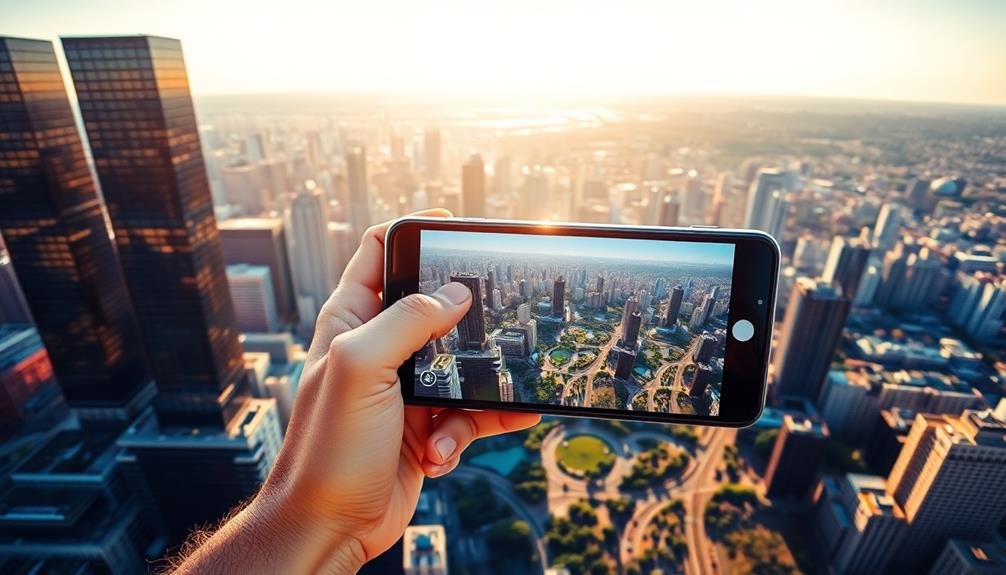



Leave a Reply